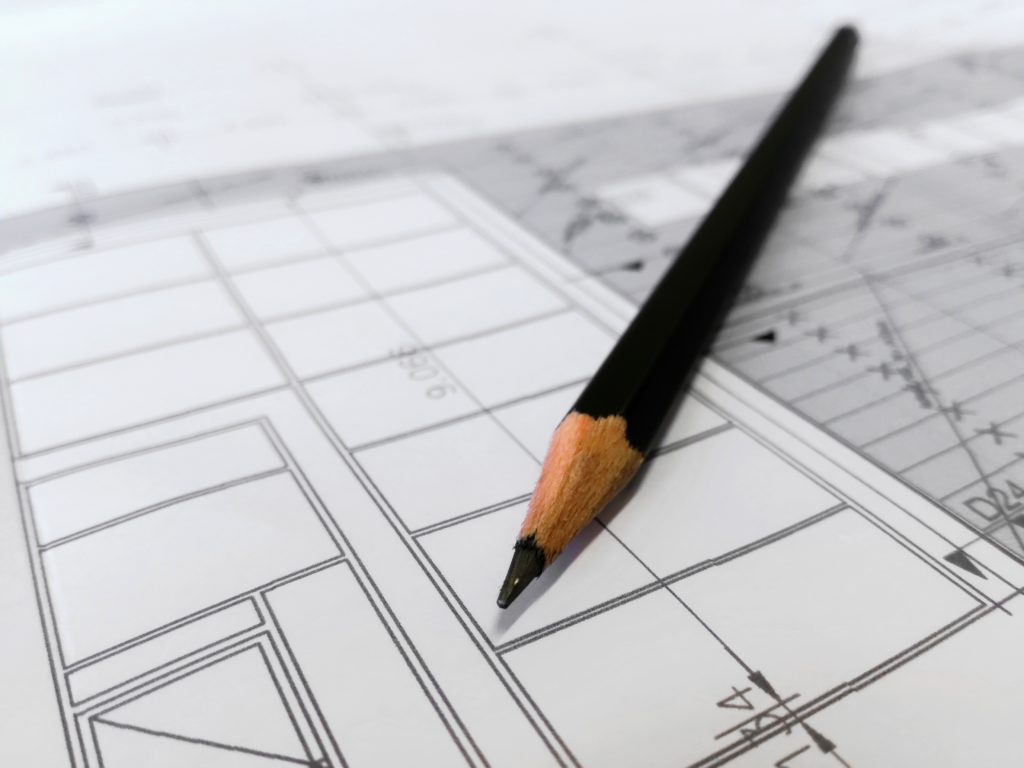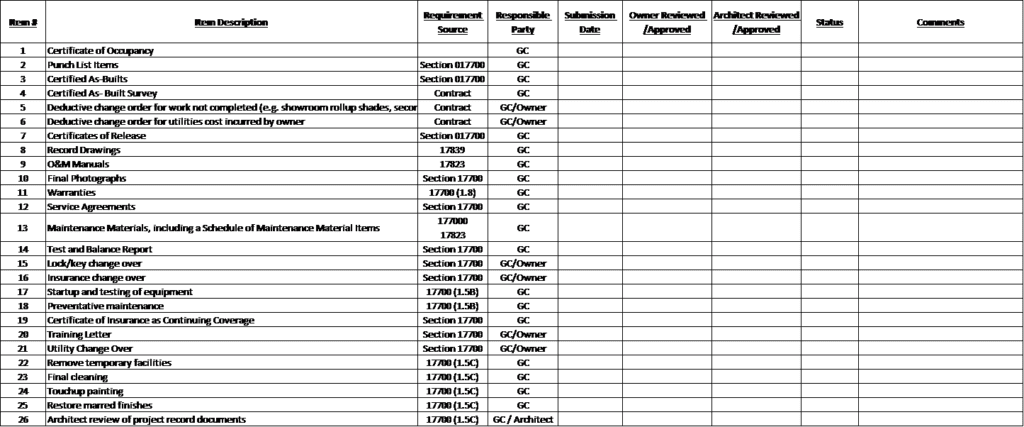Tips and Strategies for Building Owners to Closeout a Construction Project
Reading Time: 8 minutes
Winding up a construction project and transitioning occupancy to the building owner (i.e. project closeout) can be a harrowing ordeal for an owner with little to no construction experience. Even for experienced owners, Project closeout can be a challenge and is often mishandled, leading to eleventh-hour emergencies, cost overruns, and disputes. The following tips and strategies will guide a building owner to a successful closeout of a construction project.
Change orders, final payment, and lien releases
The “financial” closeout of the project could be the most crucial component of the closeout process. Before releasing final payment to the contractor, the owner should complete all of the following steps:
- Formally request that the contractor submit all change order requests, which have not been previously approved and paid. Resolve (i.e. approve or deny) all outstanding change orders, and require that the contractor’s application for final payment state the approved change orders (along with all change orders approved throughout the project duration) on the schedule of values and include them in the final contract amount.
- If the project is in Florida, strictly follow the dictates of Section 713.06(3)(d), Florida Statutes. For instance, the owner should require the contractor to submit its Contractor’s Final Payment Affidavit, and the owner may after proper notice pay direct to subcontractors and suppliers any amounts owed and stated on the Affidavit. Following this procedure will protect the owner from having to pay twice (i.e. paying the contractor, and then having to pay subcontractors/suppliers that are not paid by contractor and file liens on the property).
- Obtain final, unconditional lien releases from the contractor and all subcontractors and suppliers. In Florida, the owner should review the lien releases to ensure they comport with Section 713.20(5), Florida Statutes, along with the requirements of the prime contract, if any.
- Verify that the punch list is complete, and obtain a complete set of the project documents (discussed below).
- Work with, but do not rely upon, your lender, if any. While a borrower-owner must comply with any requirements set by its lender, we have too many times seen a lender release final payment before all of these suggested steps are completed. A lender is looking out only for its own interests, which do not always perfectly align with all of the owner’s interests. Consequently, a lender’s requirements might not always include all of the suggested steps.
Punch list administration
Most building owners are familiar with the concept of a punch list. Where we see some building owners go astray is…
- The failure to get the project’s design professionals (architects and all engineers) involved in the creation and administration of the punch list, and performance of commissioning of all systems and components. Some owner’s try to save money by electing to not pay the design professionals to administer the punch list or perform commissioning. This cost-saving decision often proves to be “penny wise, and pound foolish.” The design professionals are likely more adept than the owner at identifying incomplete or deficient work of the contractor, and can provide the dedicated attention to detail and organization required for a smooth and extensive punch list process.
- By creating a punch list that is not specific and detailed enough. Each item should be described with specificity of the issue and the location of it. We too often see punch lists with items like: “door in office does not work.” When the contractor goes to repair that item, and when the owner goes to inspect it for approval, they may not know which door it refers to if there is more than one, and may not know or may have forgotten exactly what the problem was and may not be able to identify it later. This leads to work inefficiencies, prolonged schedule, and missed items.
- Failing to meet routinely with the entire team throughout the punch list process. A prudent owner will schedule and set routine meetings throughout the expected duration of the punch list completion process to gauge and push progress of completion, to answer questions and provide clarification of owner’s intentions regarding punch list items, and give course-correcting guidance on the contractor’s performance. Failure to employ this strategy regularly results in last-minute, costly disputes over quality and completion of the work, and determining the proper date to commence move-in and occupation of the property.
Organized set of project documents
We find that it is worth the effort for a building owner to compile (or insist the contractor compile and provide to the owner) a complete, well-organized set of project documents. In today’s digital world, it is easier than ever to store and organize a large amount of documents, so why not obtain and store electronic copies of all potentially-helpful project documents. The contractor will typically create and maintain its own file of these documents, so why should the building owner not likewise keep a similar file.
Building owners will find great value in having its own project file, and being able to locate and use this information, in the operation and maintenance of the building, and just as importantly, in any dispute regarding the project that may arise in the future after completion (e.g. construction defects). Any detail that might eventually be useful in a future dispute should be documented and organized in the project closeout file. Accordingly, an electronic project file should be compiled by the owner, before making final payment to the contractor. The project file should include documents such as the following:
- Operations and maintenance manual, prepared by the contractor and reviewed and approved by design team. It should identify major design elements, systems, and materials that are crucial to the long-term quality and performance of the building (e.g., exterior wall and roof materials, windows, exterior doors, landscaping, all major operating systems and related components such as HVAC, plumbing, electrical, mechanical), and include all vendor-supplied operations and maintenance information and manuals, and all warranties and certifications that are contractually owed to the owner.
- Often overlooked, the owner should require the contractor to create a maintenance schedule (weekly, monthly, quarterly, and annually) for all major system components.
- All contracts, subcontracts, and purchase orders.
- The original schedule, and all updated schedules (in native format if possible).
- All payment applications, change orders, and records of payment.
- Daily reports of the contractor and key subcontractors.
- Drawings, specifications, RFIs, ASIs, sketches, as-built drawings and specifications, and a final document log.
- Submittals, including shop drawings, product data, samples, and mock-up records.
- Inspection reports from manufacturer reps, third-party inspectors, the contractor, owner, and design professionals.
- Punch lists, including the final punch list and punch lists from throughout the project duration, along with design team certificates.
Follow your contract and start planning early (day 1)
The time to start planning and working on project closeout is not the end of the project. Waiting until the end to start project closeout has caused many owners unnecessary stress and, more importantly, resulted in time delays, cost overruns, and disputes. Begin with the end in mind, and start on project closeout at the time of contracting the project. Here are a few tips in that regard:
- Address project closeout in the language of the contract. Codify all of the tips and strategies in this blog, and other requirements, as contractual obligations of the contractor. Ensure that such obligations are conditions precedent to final payment becoming due.
- Put all of the various requirements for project closeout on the project schedule, including durations and due dates, and set them on the critical path for final completion.
- Early in the project, create a “closeout checklist,” which identifies all of the requirements for project closeout, delegates each item to a responsible party, and tracks completion status. The checklist should be referred to throughout the project, and kept up to date as items get completed. Any items that can be completed prior to the end of the project, should be (e.g. O&M Manuals). A snippet of an example checklist is pasted below:
Conclusion
Closing out a project properly is critical to the financial and operational health of the building owner. Following the tips and strategies set forth in the blog should minimize problems that we often see in project closeouts, and avoid the costs arising from eleventh-hour emergencies and disputes.
For more on this topic, consider these additional blog articles which have related information:
Understand what final furnishing means:
- https://www.jimersonfirm.com/blog/2018/06/florida-construction-liens-final-furnishing/
- https://www.jimersonfirm.com/blog/2019/04/florida-construction-lien-final-furnishing-punchlist-punch-list-closeout-work/
- https://www.jimersonfirm.com/blog/2018/07/final-furnishing-change-order-work/
Understand lien releases in general:



